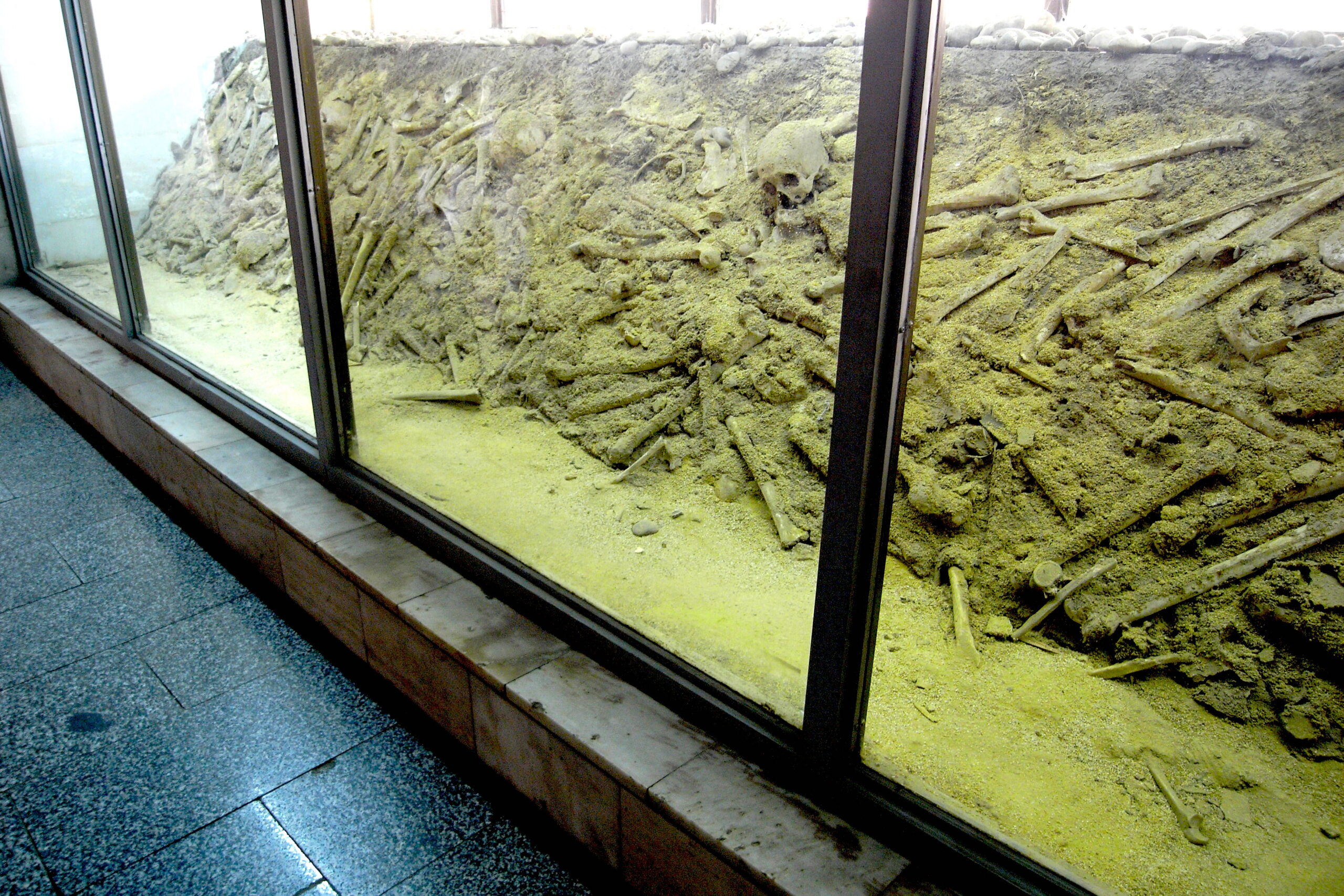 Recently, I wanted to show my wife a picture, so I opened the photos app on my phone and promptly panicked when I saw what was there.
Recently, I wanted to show my wife a picture, so I opened the photos app on my phone and promptly panicked when I saw what was there.
It’s not what you think.
A lot of people are worried about what’s lurking on their smartphones. Compromising photos. Illicit text messages. Embarrassing contacts. Porn.
What I noticed was a video in the photo stream between a picture of a document I sent to an editor and a shot of my dog — a clip of a man in Burkina Faso having his lower arm chopped off.
The still image of that act is bad enough. The video is far worse. The victim lies on the ground, pleading, screaming as another man, swinging a machete, forces him to place his right arm on a wooden bench. The attacker is trying to make the amputation easier, allowing him to make a cleaner cut. But “easier” is a relative term. The assailant hacks away, again and again and again, taking time to taunt his victim. You watch it happen. Slowly. You see the anguish on the face of the man whose arm is bleeding but mostly intact, then hanging at an odd angle, then barely attached. The video runs one minute and 18 seconds. It seems longer. Far longer. You hear the tortured screams. You watch the final swing, then see the victim kicking his legs back and forth, writhing in agony on the ground.

Mural by @donrimx in Miami. (Terence Faircloth, Flickr, CC BY-NC-ND 2.0)
I shudder to think how many similar videos and images lurk on my phone — saved in the photos, in the files, sitting in text chains from sources, colleagues, fixers, contacts. There’s the man lying in a street in the Democratic Republic of Congo as an assailant with a machete attempts to cut off his leg below the knee. I still remember the exact sound of his cries even years after first viewing it. There’s the video of the captured Kurdish fighters. I recall how the second woman to be killed — just before she’s shot in the head — watches the execution of her comrade. She doesn’t plead or cry or even flinch. Not once.
There’s the bound man shot at point blank range and kicked, still alive, into a ditch. There are the women and children forced to march to their execution. “You are going to die,” says the Cameroonian soldier, who refers to one of the women as “BH,” a reference to the terrorist group, Boko Haram. He steers her off the road and a young girl follows. Another soldier does the same to a second woman who has a toddler strapped to her back. The soldiers force the women to kneel. One of those men directs the girl to stand next to her mother. He then pulls the girl’s shirt over her head, blindfolding her. Gunshots follow.
Binging on War Porn
My career in journalism tracks the global proliferation of “war porn,” a subject that TomDispatch first covered in 2006.
In the 20th century, this particular genre consisted mostly of still photos that only rarely surfaced. The Japanese “rape” of Nanking. Murders by Nazis. Decapitations during Britain’s “Malayan Emergency.” Most of those images were trophy photos, taken by or with the consent of the perpetrators and they generally received only modest circulation. In rare cases, as in an execution in South Vietnam, they were documented by the press, made front-page news, and were sometimes even captured on film.

Mass grave exhibit at the Memorial Hall of the Victims of the Nanjing Massacre in Nanjing, China. (WL, CC BY 2.0, Wikimedia Commons)
Such photos and footage have become ubiquitous over the last two decades. As mobile phone technology has improved, cell-phone prices have dropped, and social media and messaging platforms have proliferated, people in conflict zones from Syria to Myanmar — often the perpetrators of atrocities, sometimes the victims — have been increasingly able to share video and photographic documentation of human-rights violations. During the 2010s, the Islamic State flooded the online ecosystem with gruesome execution photos and videos. Israel’s most recent attacks on civilians in Gaza have also provided a seemingly endless stream of traumatic images and video.
While news consumers may increasingly be subjected to horrific images, exposure to limited amounts is, in most cases, unlikely to cause lasting distress. Binging on such footage is a different story.
A 2014 analysis of exposure to media coverage of the Boston Marathon bombings, published in the Proceedings of the National Academy of Sciences of the United States of America, found that “repeated bombing-related media exposure was associated with higher acute stress than was direct exposure”; that is, those who consumed six or more hours a day of news coverage experienced greater stress than those who were at or near the actual bombing scene.
It’s clear that immersion in atrocity content is bad for your mental health. But what if your job is to binge-watch trauma? The work of certain journalists, social media content moderators, human rights researchers, and other analysts now has them awash in graphic “user-generated content” (UGC) or eyewitness video that can leave a lasting mark on one’s mind. The American Psychiatric Association’s 2013 Diagnostic and Statistical Manual of Mental Disorders, its official manual, states that post-traumatic stress can be brought about by exposure to the graphic details of another individual’s experience, including work-related exposure to disturbing television footage, movies, pictures or other electronic media.

Cellphone video posted to social media showing Kenosha, Wisconsin, police officers firing seven shots at 29-year-old Jacob Blake as he tries to enter his vehicle on Aug. 23, 2020. (Screengrab/Twitter)
I’ve written articles based on video footage of executions and massacres. Sometimes atrocity photos figure in my reporting, so it’s not surprising that sources often send me war porn. Still, I’m not immersed in such brutal scenes as regularly as some of my colleagues.
In 2015, the Eyewitness Media Hub conducted a survey of people who often work with graphic UGC. Even then, more than half of the 209 respondents reported that they viewed distressing media several times weekly. Twelve percent of the responding journalists and almost a quarter of the human rights and humanitarian workers said they viewed such traumatic content daily.
“You witness it a lot more with UGC,” said an anonymous senior editor at a news agency. “You’re exposed to more intense visual material than battle-hardened war cameramen sitting in Sarajevo in the middle of the 1990s because it’s coming at you from everywhere — even more so than, say, in Jerusalem. I was there at the height of the Intifada and there were body parts flying in and out of the office like nobody’s business, but there’s now a lot more of it.”
Forty percent of Eyewitness Media Hub survey respondents said that viewing such traumatic content had a negative impact on their personal lives, leaving them with feelings of isolation, flashbacks, nightmares, and other stress-related symptoms. One quarter reported high or even very high “professional adverse effects.”
In 2018, an anonymous staffer from Videre, an international charity that provides activists around the world with equipment, training, and support to gather video evidence of human-rights violations, offered a candid chronicle of the effects of two days of “cutting and splicing, frame by frame” video footage of a massacre of men, women, and children. “I went into auto-pilot: charred bodies, severed limbs,” that staffer wrote.
“They ceased to be human. I needed not to think of their lost hopes and dreams. And for two days I edited. Headphones stuck deep in my ears. The sound of desperate cries crashing around my head… And then, I started sleeping badly — waking in the night, bad dreams. I was distracted at work. It all felt so futile. A couple of weeks later, I was out walking with my partner and I started to cry.”
The next year, Casey Newton, writing for The Verge, offered a glimpse into the professional lives of Facebook’s 15,000 sub-contractor-employed content moderators. After three and a half weeks of training — immersed in hate speech, violence and graphic pornography — “Chloe” was asked to “moderate” a post in front of her fellow trainees. It was a video of a murder, a man stabbed again and again as he begged for his life. Chloe, her voice quivering, correctly informed the class that the post needed to be removed since section 13 of Facebook’s community standards prohibits videos depicting murder.
As the next potential moderator took her place, Chloe left the room to sob. After that, the panic attacks began. They continued even after Chloe left the job and hers is not an isolated case. Last year, Facebook agreed to pay $52 million to 11,250 current and former moderators to compensate them for mental-health conditions resulting from the job. There is evidence to suggest that the situation may have worsened since then as Facebook has come under increased pressure to take action against online child abuse, forcing moderators to watch greater amounts of disturbing content.

(Firesam!, Flickr, CC BY-ND 2.0)
“Even when the events depicted are far away, journalists and forensic analysts, deeply immersed in a flood of explicit, violent, and disturbing photos and video, may feel that it is seeping into their own personal headspace,” reads a fact sheet on working with traumatic imagery provided by the Dart Center for Journalism and Trauma (where I was once a fellow) at Columbia University’s Journalism School. “Intrusive recollections — re-seeing traumatic images one has been working with — are not unusual,” wrote Gavin Rees, the Dart Center’s senior adviser for training and innovation in a 2017 guide for journalists. “Our brains are designed to form vivid pictures of disturbing things, so you may experience images popping back into consciousness at unexpected moments.”
A Hammer to the Skull
Days before I saw that traumatic arm-amputation clip on my phone, I was rummaging around for an old file in the digital folders of a cloud-storage service. I noticed a folder of mine labeled “Graphic photos DRC.” I had uploaded those images — dozens of people butchered as if they were meat — while I was in the Democratic Republic of Congo in 2018. Back then, I needed to get the images off my phone but carefully labeled the folder as a warning to my editor back in the U.S., who was monitoring the material, about what lurked in that innocuous-looking digital version of a manila folder.
Not long after finding that cache of Congo carnage, I needed to contact a source via a messaging platform. I didn’t realize that it was several years since we had communicated via that app and that our last “conversation,” still sitting there, included a photo of the corpse of a colleague who had been shot through the head.
I have many other atrocity photos on thumb drives, portable hard drives, and external hard drives that sit on my desk. I know some of those photos by heart. A few from the research I did for my book Kill Anything That Moves on American war crimes in Vietnam have resided somewhere deep in the recesses of my skull for close to 20 years. Several of them that I found in the U.S. National Archives were glossy photos of the victims of an American ambush. The dead were officially reported as enemy troops, but the investigation and those photos made it clear that they were just average Vietnamese civilians — men, women, and children.
 One image burned into my brain is of a young Vietnamese boy lying lifeless on a forest floor. His glassy eyes, still open, evoke an enigmatic sense of serenity. It could be an art photo if you didn’t know that parts of his body had been obliterated by bullets and landmine fragments.
One image burned into my brain is of a young Vietnamese boy lying lifeless on a forest floor. His glassy eyes, still open, evoke an enigmatic sense of serenity. It could be an art photo if you didn’t know that parts of his body had been obliterated by bullets and landmine fragments.
Newer photos stick with me, too, like one of a heap of mostly headless bodies that no one could mistake for art, for example. I could go on, but you get the picture — or rather, I got the pictures.
I once interviewed a Vietnam veteran who had kept grisly war trophies — a small collection of atrocity images — corpses of those his unit had killed, some visibly mistreated.
In Vietnam, a surprising number of American troops amassed such photos and made grim scrapbooks out of them. Some also collected actual body parts — scalps, penises, teeth, fingers and, most commonly of all, ears. For others, like this man, the preferred anatomical souvenirs were skulls.
That veteran had held onto those war “trophies” for most of his life but, ever more aware of his advancing age, he confessed to me that one day — soon, but not yet — he needed to burn the photos and take a hammer to the skull. He didn’t want his daughter to find them when, after his death, she came to clean out his home.
For years, I wondered what it must have been like for that man to live with the skull of a Vietnamese man or woman, to wake up every morning with that specter of atrocity in his home. Only years later did I begin to grasp that I might have some idea of what that was indeed like.
I’ve never actively collected war trophies, of course. I’ve left every skull, every corpsethat I’ve encountered as I found it. But I’ve nonetheless amassed a horrific collection of war porn, far larger than anything that Vietnam veteran had.
While I don’t have a human skull in my closet, my atrocity collection is arguably far more gruesome. That veteran’s collection is still and silent, but the screams of the victims, people being butchered alive on video, are part of my collection. His trophy skull sat on a shelf hidden from view, while my compendium of horrors is scattered about my computer, cloud storage, my phone, my message chains — the totality of my digital life.
That man’s collection was finite and contained, the product of one war and one year of military service many decades ago. Mine lives with me and grows by the week. While I was writing this article, another video clip arrived. It’s horrific. At first, I couldn’t tell if the woman was dead or alive. The answer only became clear when… On second thought, you’re better off not knowing.
Nick Turse is the managing editor of TomDispatch and a fellow at the Type Media Center. He is the author most recently of Next Time They’ll Come to Count the Dead: War and Survival in South Sudan and of the bestselling Kill Anything That Moves.
This article is from TomDispatch.com.
The views expressed are solely those of the author and may or may not reflect those of Consortium News.

Nick Turse doesn’t mention it, but Chelsea Manning referred to WikiLeaks’ greatest hit, which Julian Assange titled Collateral Murder, as an example of war porn.
Fortunately I don’t encounter such scenes in my mail. But being awake at night and watching normal Italian TV is as bad. Endless footage of horrifying scenes, agonised deeply troubled and weeping faces. This is just one of many examples: a man rapes and kills five beautiful women. This does not lead anywhere; the film ends with the last murder. Even in the more normal thrillers the screaming and torture go on for much longer than necessary.
Friedlaender’s “The years of Extermination” has changed how I see humans for ever. No videos, just reading.
Thank you Nick.
Thank you Nick Turse and CN for this very important commentary on the effects of “war porn” on the psyche of those viewing such imagery. As difficult as this viewing is perhaps the public needs to see more of them / seeing what really happens to people in war and violence. Reality is not like a Hollywood movie.
Thanks.
That’s a hard read!
When people say “Thank you for your service” they shouldn’t speak that to veterans who kill people for merely living abroad — they should say it to Nick Turse and the thousands of human rights workers and journalists who document murder and war crimes for us activists to know what to fight. The deepest of thanks, Nick, for your service.
Couldn’t agree more!